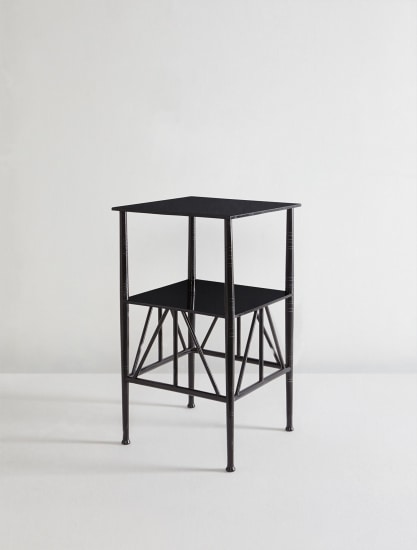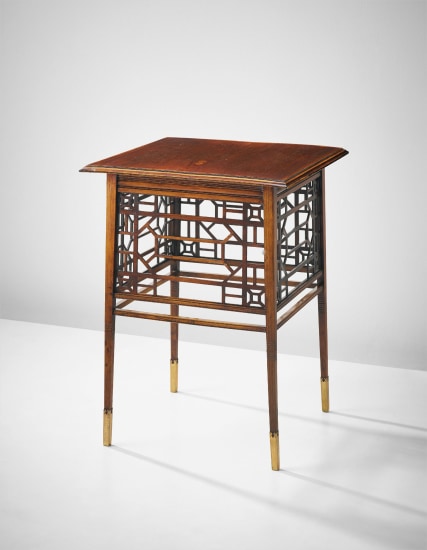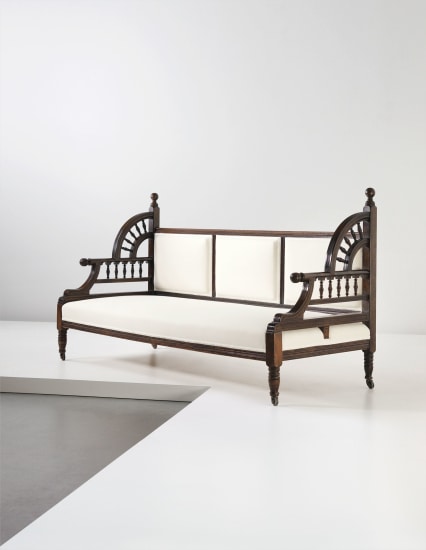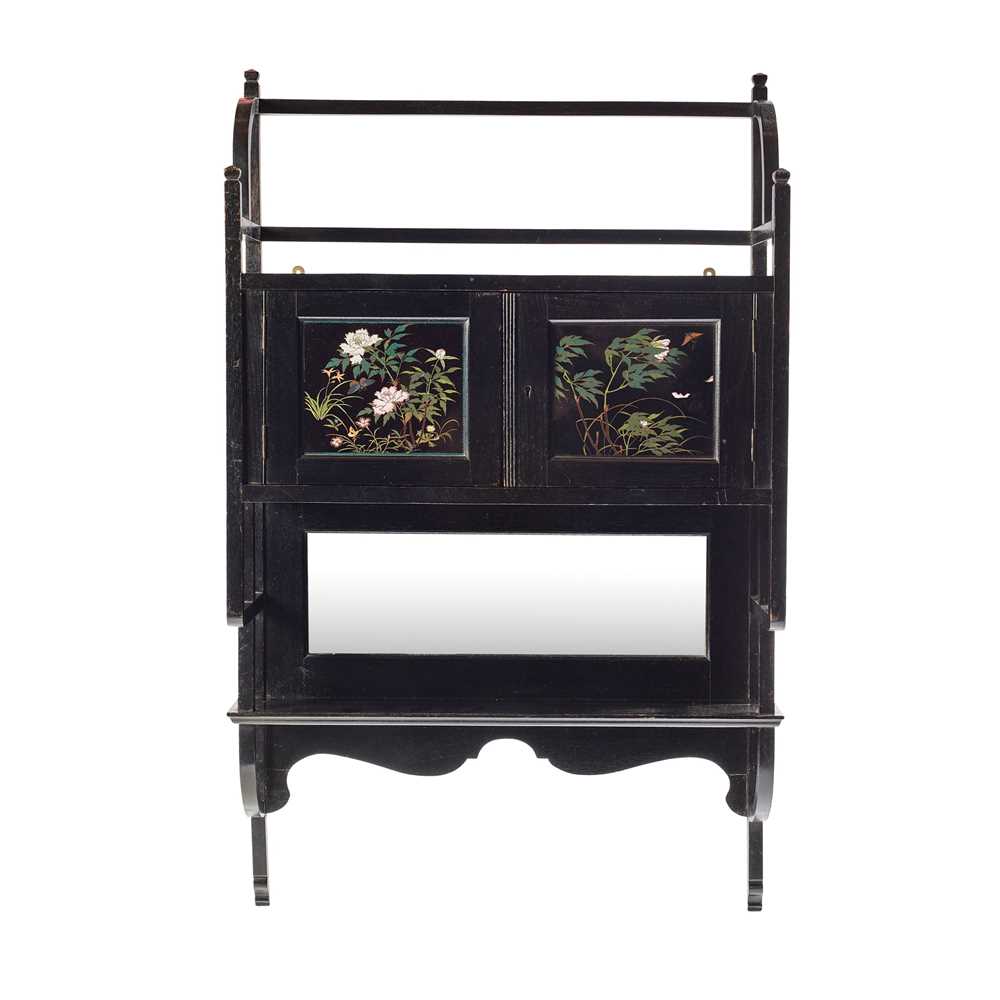PROPERTY OF A BRITISH COLLECTOR Edward William Godwin Rare early sideboard circa 1867 Ebonized wood, brass. 61 1/8 x 95 5/8 x 23 1/4 in (155.4 x 243 x 59 cm) fully extended Produced by William Watt, UK. Back of lower cupboard with maker’s enameled metal label ‘WILLIAM WATT/FURNITURE WAREHOUSE/LONDON. W.C. GOWER ST’.
Provenance Private collection, Lancashire, UK Exhibited ‘The Best of British, Design from the 19th and 20th Centuries, The Selling Exhibition’, Sotheby’s and Paul Reeves, London, March 14–20, 2008 Literature William Watt, Art Furniture from Designs by E.W. Godwin, London, 1877, pl. 6 for a drawing of a similar example Paul Reeves, ‘The Anglo-Japanese Buffet by E W Godwin, Variations on and Developments of a Design’, The Decorative Arts Society 1850 to the Present, London, no. 18, 1994, 36-40 for similar examples and an essay Susan Weber Soros, ed., E.W. Godwin: Aesthetic Movement Architect and Designer, exh. cat., The Bard Graduate Center for Studies in the Decoratives Arts, New York, 1999, pp. 239, 241 for similar examples Susan Weber Soros, The Secular Furniture of E.W. Godwin with Catalogue Raisonné, pp. 176-83 for similar examples 'The Best Of British, Design From The 19th And 20th Centuries, The Selling Exhibition', Sotheby’s and Paul Reeves, London, 2008, illustrated pp. 46-49 Catalogue Essay The present lot is one of ten known examples of the sideboard designed by Edward William Godwin in the Anglo-Japanese manner in the twenty following his move from Bristol to London in 1865. Seven of these examples—each with variations in construction, fittings, and decoration— are in the permanent collections of the following institutions: Bristol Museums and Art Gallery, Bristol; Die Neue Sammlung, Staatlisches Museum für Angewandte Kunst, Munich; Victoria and Albert Museum, London; The National Trust, Wightwick Manor, Wolverhampton; The Florida International University, Miami Beach; National Gallery of Victoria, Melbourne; and the Powerhouse Museum, Sydney. Aside from the present lot, two other examples remain in private collections, including one with glazed doors in the upper cupboards and an eight-legged sideboard also bearing a William Watt stamp. This latter example was on extended loan to the Museum of Modern Art, New York from 1984 to 1995. Edward William Godwin was a 19th-century British architect, designer, teacher, critic, and theater producer—in short an ‘aesthetic polymath’, as author Lionel Lambourne has called him. Godwin’s progressive temperament was reflected in his willingness to embrace a wide range of influences including Japanese and Chinese culture, Shakespeare, Jacobean and earlier Gothic antecedents, and ancient Greece. Godwin’s significance rests in part on his ability to distill the achievements of his forebears into a succinct, refined aesthetic. This concentration of influence in service to a new style is characterized by the present lot, an early example of his ‘Anglo-Japanese’ sideboards, the known examples of which each bear variations on a central theme, as described by Godwin: “… such effect as I wanted gained by the mere grouping of solid and void and by more or less broken outline,” (Edward William Godwin ‘MyChambers and what I did to them’, The Architect, vol. XVI, July 1, 1876, pp.4–5). Godwin’s contemporaries and associates reflected his own progressive temperament and his influence and willingness to embrace the aesthetics of Japanese culture. Godwin was a friend of the artist James McNeill Whistler who in 1877 commissioned by him to build a house on Tite Street in Chelsea, London (the house was eventually demolished in 1968). One year later in 1878, again on the same street, Godwin was commissioned by another artist, Frank Miles, to build a house where Miles was to live with Oscar Wilde. Ten years prior to this commission, Godwin, then a widower, had met the famous English Shakespearean stage actress Ellen Terry They were to have two children, daughter Edith Craig and son Edward Gordon Craig both of whom were to become prolific and influential figures in the theatre world. The public were first able to view examples of Japanese art at the International Exhibition of 1862 in London. Godwin had an innate understanding of this style, which became known as the Anglo-Japanese style. This under
PROPERTY OF A BRITISH COLLECTOR Edward William Godwin Rare early sideboard circa 1867 Ebonized wood, brass. 61 1/8 x 95 5/8 x 23 1/4 in (155.4 x 243 x 59 cm) fully extended Produced by William Watt, UK. Back of lower cupboard with maker’s enameled metal label ‘WILLIAM WATT/FURNITURE WAREHOUSE/LONDON. W.C. GOWER ST’.
Provenance Private collection, Lancashire, UK Exhibited ‘The Best of British, Design from the 19th and 20th Centuries, The Selling Exhibition’, Sotheby’s and Paul Reeves, London, March 14–20, 2008 Literature William Watt, Art Furniture from Designs by E.W. Godwin, London, 1877, pl. 6 for a drawing of a similar example Paul Reeves, ‘The Anglo-Japanese Buffet by E W Godwin, Variations on and Developments of a Design’, The Decorative Arts Society 1850 to the Present, London, no. 18, 1994, 36-40 for similar examples and an essay Susan Weber Soros, ed., E.W. Godwin: Aesthetic Movement Architect and Designer, exh. cat., The Bard Graduate Center for Studies in the Decoratives Arts, New York, 1999, pp. 239, 241 for similar examples Susan Weber Soros, The Secular Furniture of E.W. Godwin with Catalogue Raisonné, pp. 176-83 for similar examples 'The Best Of British, Design From The 19th And 20th Centuries, The Selling Exhibition', Sotheby’s and Paul Reeves, London, 2008, illustrated pp. 46-49 Catalogue Essay The present lot is one of ten known examples of the sideboard designed by Edward William Godwin in the Anglo-Japanese manner in the twenty following his move from Bristol to London in 1865. Seven of these examples—each with variations in construction, fittings, and decoration— are in the permanent collections of the following institutions: Bristol Museums and Art Gallery, Bristol; Die Neue Sammlung, Staatlisches Museum für Angewandte Kunst, Munich; Victoria and Albert Museum, London; The National Trust, Wightwick Manor, Wolverhampton; The Florida International University, Miami Beach; National Gallery of Victoria, Melbourne; and the Powerhouse Museum, Sydney. Aside from the present lot, two other examples remain in private collections, including one with glazed doors in the upper cupboards and an eight-legged sideboard also bearing a William Watt stamp. This latter example was on extended loan to the Museum of Modern Art, New York from 1984 to 1995. Edward William Godwin was a 19th-century British architect, designer, teacher, critic, and theater producer—in short an ‘aesthetic polymath’, as author Lionel Lambourne has called him. Godwin’s progressive temperament was reflected in his willingness to embrace a wide range of influences including Japanese and Chinese culture, Shakespeare, Jacobean and earlier Gothic antecedents, and ancient Greece. Godwin’s significance rests in part on his ability to distill the achievements of his forebears into a succinct, refined aesthetic. This concentration of influence in service to a new style is characterized by the present lot, an early example of his ‘Anglo-Japanese’ sideboards, the known examples of which each bear variations on a central theme, as described by Godwin: “… such effect as I wanted gained by the mere grouping of solid and void and by more or less broken outline,” (Edward William Godwin ‘MyChambers and what I did to them’, The Architect, vol. XVI, July 1, 1876, pp.4–5). Godwin’s contemporaries and associates reflected his own progressive temperament and his influence and willingness to embrace the aesthetics of Japanese culture. Godwin was a friend of the artist James McNeill Whistler who in 1877 commissioned by him to build a house on Tite Street in Chelsea, London (the house was eventually demolished in 1968). One year later in 1878, again on the same street, Godwin was commissioned by another artist, Frank Miles, to build a house where Miles was to live with Oscar Wilde. Ten years prior to this commission, Godwin, then a widower, had met the famous English Shakespearean stage actress Ellen Terry They were to have two children, daughter Edith Craig and son Edward Gordon Craig both of whom were to become prolific and influential figures in the theatre world. The public were first able to view examples of Japanese art at the International Exhibition of 1862 in London. Godwin had an innate understanding of this style, which became known as the Anglo-Japanese style. This under













Try LotSearch and its premium features for 7 days - without any costs!
Be notified automatically about new items in upcoming auctions.
Create an alert